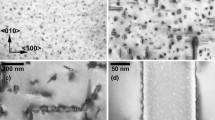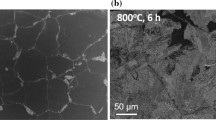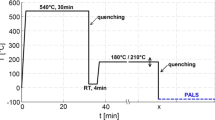Abstract
The clustering kinetics in quenched pure Al, binary Al–Mg and binary Al–Si alloys were studied by positron annihilation lifetime spectroscopy (PALS) and differential scanning calorimetry (DSC) during natural ageing (NA). Shortly after quenching, positrons annihilate either in the bulk material or in vacancy-type defects such as mono-vacancies (in Al) and vacancy–solute complexes (in Al–Mg and Al–Si alloys). Upon NA, vacancy clusters of various sizes and number densities are formed. In Al, such clusters contain typically 3 vacancies. In Al–Mg and Al–Si alloys, complexes containing various vacancies and also solute atoms are formed. The presence of shallow positron traps was detected in temperature-dependent positron lifetime experiments. They were identified as quenched-in dislocations rather than Mg or Si clusters as no solute clustering signal during NA was observed in DSC runs of the binary Al–Mg and Al–Si alloys.









Similar content being viewed by others
Notes
Note that positron affinities are usually calculated for extended bulk materials (or with respect to the interface of two bulk materials). Thus, positron affinities calculated in this way do not necessarily correspond to positron affinities of single atoms inside a host matrix.
References
Hirsch PB, Silcox J, Smallman RE, Westmacott KH (1958) Dislocation loops in quenched aluminium. Philos Mag 3:897–908
Luna CR, Macchi C, Juan A, Somoza A (2013) Vacancy clustering in pure metals: some first principle calculations of positron lifetimes and momentum distributions. J Phys Conf Ser 443:012019
Fischer FD, Svoboda J, Appel F, Kozeschnik E (2011) Modeling of excess vacancy annihilation at different types of sinks. Acta Mater 59:3463–3472
Panseri C, Federighi T (1958) Isochronal annealing of vacancies in aluminium. Philos Mag 3:1223–1240
Panseri C, Gatto F, Federighi T (1958) Interaction between solute magnesium atoms and vacancies in aluminium. Acta Metall 6:198–204
Ozawa E, Kimura H (1970) Excess vacancies and nucleation of precipitates in aluminum-silicon alloys. Acta Metall 18:995–1004
Banhart J, Chang CST, Liang ZQ, Wanderka N, Lay MDH, Hill AJ (2010) Natural aging in Al–Mg–Si alloys–a process of unexpected complexity. Adv Eng Mater 12:559–571
Panseri C, Federighi T (1966) A resistometric study of precipitation in an aluminium-1.4 percent Mg2Si alloy. J I Met 94:99–197
Banhart J, Lay MDH, Chang CST, Hill AJ (2011) Kinetics of natural aging in Al–Mg–Si alloys studied by positron annihilation lifetime spectroscopy. Phys Rev B 83:014101
Pashley DW, Rhodes JW, Sendorek A (1966) Delayed ageing in aluminium-magnesium-silicon alloys: effect on structure and mechnical properties. J I Met 94:41–49
Liu M (2014) Clustering kinetics in Al–Mg–Si alloys investigated by positron annihilation techniques. PhD Dissertation, Technische Universität Berlin
Lay MDH, Zurob HS, Hutchinson CR, Bastow TJ, Hill AJ (2012) Vacancy behavior and solute cluster growth during natural aging of an Al–Mg–Si alloy. Metall Mater Trans A 43A:4507–4513
De Geuser F, Lefebvre W, Blavette D (2006) 3D atom probe study of solute atoms clustering during natural ageing and pre-ageing of an Al–Mg–Si alloy. Phil Mag Lett 86:227–234
Murayama M, Hono K, Saga M, Kikuchi M (1998) Atom probe studies on the early stages of precipitation in Al–Mg–Si alloys. Mat Sci Eng A 250:127–132
Klobes B, Maier K, Staab TEM (2015) Early stage ageing effects and shallow positron traps in Al–Mg–Si alloys. Philos Mag 95:1414–1424
Liu M, Čižek J, Chang CST, Banhart J (2015) Early stages of solute clustering in an Al–Mg–Si alloy. Acta Mater 91:355–364
Liu M, Yan Y, Liang ZQ, Chang CST, Banhart J (2012) Influence of Mg and Si atoms on the cluster formation process in Al–Mg–Si alloys studied by positron annihilation lifetime spectroscopy. In: Weiland H, Rollett AD, Cassada WA (eds), Proceedings of the 13th International Conference on Aluminium Alloys (ICAA13), Pittsburgh, pp 1131–1137
Lengeler B (1976) Quenching of high-quality gold single-crystals. Philos Mag 34:259–264
Dannefaer A (1981) On the effect of backscattering of γ quanta and statistics in positron-annihilation lifetime measurements. Appl Phys A 26:255–259
Dorikens-Vanpraet L, Segers D, Dorikens M (1980) The influence of geometry on the resolution of a positron annihilation lifetime spectrometer. Appl Phys 23:149–152
Banhart J, Liu M, Yan Y et al (2012) Study of ageing in Al–Mg–Si alloys by positron annihilation spectroscopy. Physica B 407:2689–2696
Leighly HP (2006) Positron annihilation of defects in metals and alloys. In: Mackenzie DS, Totten GE (eds) Analytical characterization of aluminum, steel, and superalloys. Taylor & Francis, Boca Raton, pp 661–676
Kansy J (1996) Microcomputer program for analysis of positron annihilation lifetime spectra. Nucl Instru Meth Phys Res A 374:235–244
Gottstein G (1998) Physikalische Grundlagen der Materialkunde. In: Kristallbaufehler. Springer, Berlin, pp 67–70
Carling KM, Wahnström G, Mattsson TR, Sandberg N, Grimvall G (2003) Vacancy concentration in Al from combined first-principles and model potential calculations. Phys Rev B 67:054101
Ehrhart P, Jung P, Schultz H, Ullmaier H (1991) Landolt-Börnstein, New series III/25. In: Ullmaier H (ed) Atomic defects in metals · Al. Springer, Berlin, pp 211–223
Seeger A (1973) Investigation of point defects in equilibrium concentrations with particular reference to positron annihilation techniques. J Phys F 3:248–294
Staab TEM, Zschech E, Krause-Rehberg R (2000) Positron lifetime measurements for characterization of nano-structural changes in the age hardenable AlCuMg 2024 alloy. J Mater Sci 35:4667–4672
Puska M, Nieminen RM (1983) Defect spectroscopy with positrons: a general calculational method. J Phys F Met Phys 13:333–346
Schaefer HE (1987) Investigation of thermal-equilibrium vacancies in metals by positron annihilation. Phys Status Solidi A 102:47–65
Gavini V, Bhattacharya K, Ortiz M (2007) Vacancy clustering and prismatic dislocation loop formation in aluminum. Phys Rev B 76:180101
Krause-Rehberg R, Leipner HS (1999) Positron annihilation in semiconductors. Springer, Heidelberg
Nieminen RM, Laakkonen J (1979) Positron trapping rate into vacancy clusters. Appl Phys 20:181–184
Royset J, Stene T, Seater JA, Reiso O (2006) The effect of intermediate storage temperature and time on the age hardening response of Al-Mg-Si alloys, Aluminium Alloys 2006, Pts 1 and 2 519–521: 239–244
Calloni A, Dupasquier A, Ferragut R et al (2005) Positron localization effects on the Doppler broadening of the annihilation line: aluminum as a case study. Phys Rev B 72:054112
Dlubek G, Gerber W, Vehanen A, Ylikauppila J (1980) A positron annihilation study of vacancies and their clusters in diluted aluminum alloys quenched or neutron-irradiated. Cryst Res Technol 15:1409–1413
Dlubek G, Brummer O, Moser B (1981) A positron annihilation study of quenched-in defects in diluted Al–Mg alloys. Phys Status Solidi A 63:K115–K118
Stott MJ, Kubica P (1975) New approach to the positron distribution in metals and alloys. Phys Rev B 11:1–10
Puska MJ, Nieminen RM (1989) Positron affinities for elemental metals. J Phys Condens Matter 1:6081–6093
Lang P, Shan YV, Kozeschnik E (2014) The life-time of structural vacancies in the presence of solute trapping. Mater Sci Forum 794–796:963–970
Corbel C, Gupta RP (1981) Positron lifetime in vacancy-impurity complexes. J Phys Lett 42:547–550
Melikhova O, Kuriplach J, Čižek J, Prochazka I (2006) Vacancy-solute complexes in aluminum. Appl Surf Sci 252:3285–3289
Segers D, van Mourik P, van Wijingaarden MH, Rao BM (1984) Precipitation of silicon in a solid quenched aluminium–silicon (1.3 at%) alloy studied by positron annihilation. Physica Status Solidi A 81:209–216
Liang ZQ, Chang CST, Abromeit C, Banhart J, Hirsch J (2012) The kinetics of clustering in Al–Mg–Si alloys studied by Monte Carlo simulation. Int J Mater Res 103:980–986
Mantina M, Wang Y, Chen LQ, Liu ZK, Wolverton C (2009) First principles impurity diffusion coefficients. Acta Mater 57:4102–4108
Wert C, Zener C (1949) Interstitial atomic diffusion coefficients. Phys Rev 76:1169–1175
Vineyard GH (1957) Frequency factors and isotope effects in solid state rate processes. J Phys Chem Solids 3:121–127
Adams JB, Foiles SM, Wolfer WG (1989) Self-diffusion and impurity diffusion of FCC metals using the 5-frequency model and the embedded atom method. J Mater Res 4:102–112
Hirosawa S, Nakamura F, Sato T (2007) First-principles calculation of interaction energies between solutes and/or vacancies for predicting atomistic behaviors of microalloying elements in aluminum alloys. Mater Sci Forum 561–565:283–286
Hoshino T, Zeller R, Dederichs PH (1996) Local-density-functional calculations for defect interactions in Al. Phys Rev B 53:8971–8974
Dlubek G, Krause R, Brummer O, Plazaola F (1986) Study of formation and reversion of Guinier-Preston zones in Al-4.5at-percent-Zn-Xat-percent-Mg alloys by positrons. J Mater Sci 21:853–858
Krause R, Dlubek G, Brummer O, Skladnikiewitz S, Daut H (1985) Nucleation and precipitation in an Al–Si(1 at-percent) alloy investigated by positron annihilation. Cryst Res Technol 20:267–269
Somoza A, Petkov MP, Lynn KG (2002) Stability of vacancies during solute clustering in Al–Cu based alloys. Phys Rev B 65:094107
Zou B, Chen ZQ, Liu CH, Chen JH (2014) Vacancy-Mg complexes and their evolution in early stages of aging of Al–Mg based alloys. Appl Surf Sci 298:50–55
Dlubek G, Brummer O, Hautojarvi P (1986) A positron study of precipitation phenomena in Al–Ge and Al–Si alloys. Acta Metall 34:661–667
Pagh B, Hansen HE, Nielsen B, Trumpy G, Petersen K (1984) Temperature dependence of positron annihilation parameters in neutron irradiated molybdenum. Appl Phys A 33:255–263
Saarinen K, Hautojarvi P, Vehanen A, Krause R, Dlubek G (1989) Shallow positron traps in GaAs. Phys Rev B 39:5287–5296
Gupta AK, Lloyd DJ (1999) Study of precipitation kinetics in a super purity Al-0.8 Pct Mg-0.9 Pct Si alloy using differential scanning calorimetry. Metall Mater Trans A 30:879–884
Bouchear M, Hamana D, Laoui T (1996) GP zones and precipitate morphology in aged Al–Mg alloys. Phil Mag A 73:1733–1740
Nozato R, Ishihara S (1980) Calorimetric study of precipitation process in Al–Mg alloys. T Jpn I Met 21:580–588
Roth M, Raynal JM (1974) Small-angle neutron scattering by Guinier-Preston zones in Al–Mg alloys. J Appl Crystallogr 7:219–221
Thomas G (1959) Quenching defects in binary aluminium alloys. Philos Mag 4:1213–1228
Smedskjaer LC, Manninen M, Fluss MJ (1980) An alternative interpretation of positron annihilation in dislocations. J Phys F Met Phys 10:2237
Dupasquier A, Romero R, Somoza A (1993) Positron trapping at grain boundaries. Phys Rev B 48:9235
Hashimoto E, Kino T (1991) Temperature dependence of positron trapping to dislocations in aluminum. J Phys Soc Jpn 60:3167
Westmacott KH, Hull D, Barnes RS, Smallman RE (1959) Dislocation sources in quenched aluminium-based alloys. Philos Mag 4:1089–1092
Del Rio J, De Diego N, Plazaola F (1998) Temperature dependence of positron trapping at defects in an Al–Li alloy. J Phys Condens Matter 10:5327–5333
Kiritani M (1964) Formation of voids and dislocation loops in quenched aluminum. J Phys Soc Jpn 19:618–631
Starink MJ, Zahra AM (1998) Kinetics of isothermal and non-isothermal precipitation in an Al-6 at% Si alloy. Phil Mag A 77:187–199
Acknowledgement
The Deutsche Forschungsgemeinschaft (DFG) funded this project (Ba 1170/22, STA 527/3). Hydro Aluminium in Bonn provided the alloys investigated. Support from Prof. K. Maier (University Bonn), Prof. R. Krause-Rehberg (University Halle) and Mrs. C. Förster (Helmholtz-Zentrum Berlin) is sincerely acknowledged.
Author information
Authors and Affiliations
Corresponding author
Ethics declarations
Conflict of interest
The authors declare that they have no conflict of interest.
Rights and permissions
About this article
Cite this article
Liu, M., Klobes, B. & Banhart, J. Positron lifetime study of the formation of vacancy clusters and dislocations in quenched Al, Al–Mg and Al–Si alloys. J Mater Sci 51, 7754–7767 (2016). https://doi.org/10.1007/s10853-016-0057-7
Received:
Accepted:
Published:
Issue Date:
DOI: https://doi.org/10.1007/s10853-016-0057-7




